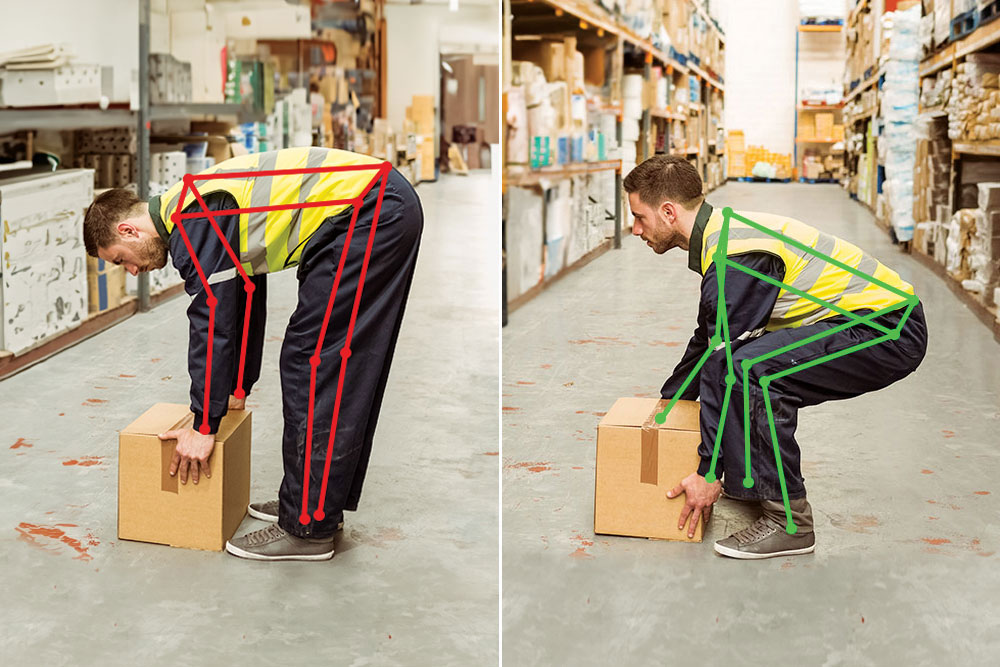
Manual handling is a leading cause of work-related injuries, but it’s also necessary in many workplaces. This presents a significant challenge for employers: How can you ensure that essential manual handling is safe 100% of the time?
Investing in equipment can help reduce injury risks, but it’s not always practical or affordable. Fortunately, there’s another option: effective training.
In this blog, we’ll explore how innovations in manual handling equipment and training can help you protect your workforce.
We’ll also introduce you to the Ergo Analyser, an AI-powered tool that transforms the way workers learn and apply safe lifting techniques. By the end, you’ll understand why investing in advanced manual handling training is often the more practical solution for improving workplace safety.
Key Takeaways
- UK law requires employers to avoid manual handling tasks where possible and manage any remaining risks.
- Innovations in manual handling equipment can help reduce injury risks, but they aren’t always practical or affordable for every business.
- Training is a more cost-effective solution to manage manual handling risks. It can equip workers with the skills to handle loads safely and adapt to different tasks.
- Human Focus offers the Ergo Analyser, an AI-powered app that provides real-time feedback. It helps workers apply training in real-world situations and develop safer handling habits.
What the Law Says
In the UK, employers are legally required to manage the risks associated with manual handling. The foundation of this obligation is the Health and Safety at Work Act 1974, which places a general duty on employers to ensure the health, safety, and welfare of their employees.
Building on this, the Manual Handling Operations Regulations 1992 (MHOR) set out specific actions employers must take to manage manual handling risks. Under MHOR, you must:
- Avoid hazardous manual handling tasks as much as possible
- Assess any manual handling operations that can’t be avoided
- Reduce the risk of injury to the lowest level that’s reasonably practicable
Manual Handling Training
Our Manual Handling training course helps users ensure that they are sufficiently trained in the principles and practices of safe manual handling to control and minimise manual handling-related injuries and to ensure a safe workplace for all.
Innovations in Manual Handling Equipment that Reduce Injury Risks
Under MHOR, employers must consider how to eliminate the need for manual handling before considering other measures. This is why risk assessments are so critical; by evaluating tasks, you can identify opportunities to replace manual handling with safer alternatives.
Innovations in manual handling equipment play a crucial role in meeting these legal requirements. For example, equipment like trolleys, hoists and conveyor systems can significantly reduce the need for workers to lift or carry loads manually. This minimises the risk of injury and helps businesses stay compliant with health and safety regulations.
What This Means for Employers
Employers must take steps to protect their workers from manual handling injuries. The priority is to avoid manual handling wherever possible, which often means using equipment or automation to reduce the need for workers to lift, carry or move loads by bodily force.
But risk controls must be practical and proportional to the risk.
Manual handling equipment can help reduce the physical strain on workers, but it doesn’t fit every budget or workspace. Automation or robotics also offer solutions, but these options aren’t realistic for all material handling operations.
So, there’s no expectation to invest in expensive equipment or technology unless it’s reasonable for your organisation and the risks your workers face.
Fortunately, there is an option that suits all workplaces, regardless of size or budget.
Why Training is a Better Option
For most workplaces, training is the most practical and cost-effective way to manage manual handling risks.
It’s more affordable than investing in expensive equipment, and it equips workers with the skills to assess tasks and problem-solve on the job. This means workers are better prepared to adapt to changing situations and handle loads safely, no matter what happens during the workday.
Plus, when employees understand the principles of safe manual handling, they’re more likely to take responsibility for their safety and work together to reduce risks.
The Limitations of Traditional Training
But traditional manual handling training does have limitations. It tends to focus heavily on theory, which can make it difficult for workers to apply material handling techniques they’ve learned in a classroom on the job.
Another common problem is that traditional training is rarely repeated. Without reinforcement, workers typically forget what they’ve learned and slip back into unsafe practices.
Finally, many traditional training programmes fail to provide personalised feedback. Without specific, actionable advice, workers can’t develop the precise handling skills that are essential for reducing injury risks.
How You Can Overcome These Issues
So traditional manual handling training faces three main problems:
- It often focuses too much on theory
- Training sessions are rarely repeated
- There’s a lack of personalised feedback
So, how can you overcome these issues without paying for external training providers to come in every day?
The Ergo Analyser is one option.
The Ergo Analyser
The Ergo Analyser is an AI-powered tool that provides real-time feedback on workers’ manual handling techniques. It uses video analysis to identify unsafe lifting and offer tailored advice on how to improve. This makes it easier for workers to build safer handling habits over time and reduces the risk of injuries caused by poor technique.

When combined with Human Focus’s Manual Handling Training course, the Ergo Analyser becomes even more effective. Workers start by learning the essential manual handling techniques through the online training course. They then use the Ergo Analyser to put this knowledge into practice in their work environment. The tool offers real-time, personalised feedback, helping them apply what they’ve learned and develop safer practices on the job.
By blending theory with practical experience, online training and the Ergo Analyser create a comprehensive, long-term approach to manual handling safety.
Manual Handling Training
Our online Manual Handling Training course offers a practical, affordable solution that equips workers with the skills they need to handle loads safely and efficiently.
By combining this training with the Ergo Analyser, you’ll get a comprehensive approach that goes beyond theory. Workers don’t just learn about safe handling techniques; they put them into practice and receive real-time feedback, helping them build safer habits over time. This approach leads to a safer work environment, fewer injuries and greater productivity.





















